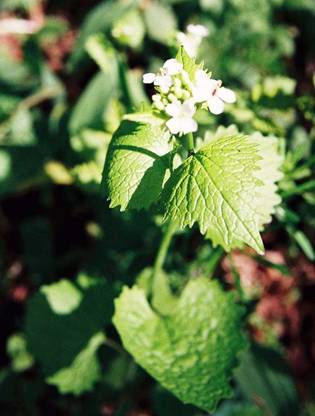THE BIOGEOGRAPHER
Newsletter of the Biogeography Specialty Group of the Association of American Geographers
Electronic Version Volume 6 No. 1 Fall 2005
BSG Executive Board
Joy Nystrom Mast (President), Carthage College
Mary Ann Cunningham Vassar College; David Cairns, Texas A&M University;
Charles Lafon, Texas A&M University; Jim Speer, Indiana State University
Taly Drezner (Secretary-Treasurer), University of Wisconsin-Milwaukee;
Duane Griffin (Editor), Bucknell University
Contents:
Greetings fellow biogeographers. Currently, I serve on the National Science Foundation’s Geography and Regional Science (GRS) panel that reviews geography grant applications. After participating in reviewing over 480 grant proposals thus far, I have been pondering what it takes to actually secure NSF funding. As a side note, another panel judges doctoral research proposals, so I can’t offer specific advice to graduate students for that competition (although these tips should help too).
 Here is how the grant review process works. The NSF panel meets twice a year and reviews around 160+ proposals at each meeting. Each grant proposal is first sent out for six or more external reviews, and also sent out to be reviewed by the fourteen GRS panel members. All of the written reviews are then submitted into the Fastlane Review system. The panel meets in Washington D.C. for two intense days of reviewing and categorizing the proposals into funding recommendations. During these panel meetings, one panel member is in charge of presenting each proposal to the full panel and summarizing the key points from the external reviews. A second panel member is in charge of also carefully reviewing the proposal and external reviews to provide a second opinion. Following discussion by the full panel, the proposal is “judged” on a five level gradient ranging from “not fundable” to “excellent—highest priority for funding”. My ponderings on this process will focused on what it actually takes for a grant to move from the fourth highest level, “very good” (= no funding, in many cases), to the highest level, “excellent” (= funded, in most cases).
Here is how the grant review process works. The NSF panel meets twice a year and reviews around 160+ proposals at each meeting. Each grant proposal is first sent out for six or more external reviews, and also sent out to be reviewed by the fourteen GRS panel members. All of the written reviews are then submitted into the Fastlane Review system. The panel meets in Washington D.C. for two intense days of reviewing and categorizing the proposals into funding recommendations. During these panel meetings, one panel member is in charge of presenting each proposal to the full panel and summarizing the key points from the external reviews. A second panel member is in charge of also carefully reviewing the proposal and external reviews to provide a second opinion. Following discussion by the full panel, the proposal is “judged” on a five level gradient ranging from “not fundable” to “excellent—highest priority for funding”. My ponderings on this process will focused on what it actually takes for a grant to move from the fourth highest level, “very good” (= no funding, in many cases), to the highest level, “excellent” (= funded, in most cases).
Without referring to actual proposals submitted, I would like to
share with you some tips on making that seemingly small leap on the
continuum from “very good” to “excellent”. I’ll start with the evaluation of the two main criteria, intellectual merit and broader implication. For intellectual merit, the reviewer needs to see how your research will contribute to basic science, even if it is also applied research. When evaluating the intellectual basis of a proposal, the panel is looking for theory. Successful proposals have the following characteristics: (1) draws on and show great promise in expanding and/or creating theory; (2) shows broader impacts of theory on many subfields of geography (remember it is a diverse panel of geographers reviewing these grants); and (3) clearly states the hypotheses to be tested (not just objectives of study). The current catch-phrase for reviewing proposals is “maximum connectivity”, referring to integrating research across a range of sub-disciplines. As a tip, even though the reviewers are looking for impacts on many subfields, they are also looking at the qualifications of the proposer (individual or team) to conduct the project. For example, if you are a trying to add climatology component to your research proposal, then might want to either add a climatologist to your team or be sure to stress how you have the training and knowledge to conduct climatology research. If not, then the climatology expert on the GRS panel likely would recommend not funding your proposal based on lack of expertise in that subdiscipline. One area that would help get funding for many proposals is adding a modeling component (and a modeler to the proposal team, if needed).
The second area, broader implications, focuses on how your results will impact and apply to several areas: education, diversity, infrastructure, and society. For education, you need to state that you will impact students, especially undergraduates. If you only plan to fund a couple graduate students, then your proposal will not stand out from all the others. Some successful ideas are to state how you would train undergraduates in field or lab research, teach a seminar class using the research, develop K-12 materials, and/or work with local museums or environmental educations programs. For diversity, the reviewers seem to be focusing on ethnic minorities instead of women. You would need to specifically state how you would recruit minority students to work on the project and/or organize a program of outreach for minorities. With regards to infrastructure, the panel is looking for how your proposal would develop new technology, models, databases, and/or possibly fund big-ticket items for your research. Data sharing is also highly regarded, such as putting your results into an international database. Finally, there needs to be societal significance to your proposed work. Simply presenting your work at academic conferences and publishing it in peer-reviewed journals will not distinguish your proposals from the others. You might wish to state how your research would be valuable to nonacademics (like US Forest Service) as well as the communities around your study area (such as planners and resource managers). Letters of support from agencies are very helpful to show potential societal impacts (especially if the agency serves minorities, such as Native American reservation lands)
Finally, a few other tips might also help edge you into the excellent-fund category. First, if you are working at an undergraduate college, the there is a special funding source to encourage research at undergraduate institutions. Your proposal would be reviewed with all the others, but you would be able to access funding set aside for undergraduate colleges. A tip for this case would be to stress senior thesis research assistance and funding for undergraduate lab and field supplies. Second, avoid already answering the main questions you pose in your research proposal. Instead, first show the background of what has been done in the past (by you and/or others) then contrast it with what will be unique in this proposed research (focus on what your research will do that is new). Third, if you are asked to review a proposal for NSF and you think it is excellent, then by all means say so! The more excellent ratings from external reviewers the more likely the research will get funded. Finally, if your proposal receives a “good” or “very good” rating but no funding, then read all the reviewers comments, revise, and resubmit for the next round of funding
(and summarize in the proposal how you have addressed these comments). Good luck to all and I hope NSF is able to fund many biogeographers in the future.
Joy Nystrom Mast
Back to the top.
Grad Student Representative's Column
New Feature!
I would like to very happily announce the creation of a new column in the Biogeographer devoted purely to students. There is currently no set topic for this column, so it will likely become what we as students make it. The column will be a great way for us to voice our opinions or concerns, discuss the future direction of biogeographical research, or just discuss some of the cool research that we are currently conducting (and judging from the paper and poster presentations in Denver, there is a lot of it). I am hoping this column will evolve into something that biogeography students worldwide and from all aspects of the discipline will contribute. As future professors and researchers, it is essential that we as students communicate not only with our advisors, but with other professors, researchers, and students to fully understand the scope and importance of biogeographical research. So, if you have an idea for a future column or a portion of a future column, please contact me.
I would like to take the opportunity in this first column to provide some information on the evolving role of students in the Biogeography Specialty Group (BSG). With the creation of my current position (Graduate Student Representative on the BSG Board) the BSG has made it clear that they want students to be a larger part of deciding how the BSG is run and how it can be more successful. As the first ever BSG graduate student representative I am currently focusing on creating better modes of communication between students. This should provide us with the groundwork necessary to discuss what we feel is most important to us as a group and develop ideas on the future directions of the BSG.
As a first step in improving this communication, Dr. Henri Grissino-Mayer and I have created the Biogeography Specialty Group Graduate Student Listserv (BSG-GRAD List). This listserv is devoted purely to student members of the BSG and is intended to serve as a way for students to discuss anything relating to biogeography, which can include teaching, research, meetings, job openings, etc. If you are a student member of the BSG and have not yet joined the listserv, I highly recommend you do so. To join, or if you have any questions about the listserv, please send me an e-mail with your full name and e-mail address. My e-mail address is clane6@utk.edu.
I would also like to take this opportunity to solicit opinions and ideas from all members of the BSG on what they would like to see from me and future graduate student board members. Our former president, Dr. John Kupfer, and our current president, Dr. Joy Mast, have both made several excellent suggestions on what they would like to see from the graduate student representative. Some ideas have included paper sessions at the next national meeting devoted purely to issues or themes key to biogeography graduate students and the organization of ‘mentor lunches’, where we try to schedule meetings between students and professionals of their choosing at the national meeting. None of these ideas are set in stone, so now is the time to contact me with any further ideas regarding the current and future role of the graduate student representative. Again, my e-mail address is clane6@utk.edu.
As a first attempt at organizing such events I have assembled a panel discussion for the upcoming national AAG meeting in Chicago. The title of this session will be “Employment as a Biogeographer: Prospects, Insights, and Advice”. I have tried to assemble a panel with a wide range of professional backgrounds to provide as much useful information to students as possible. The session will included both U.S. and international panelists with experience ranging from recent employment in academia, to department heads with considerable experience in the world of academia, to biogeographers who have worked for non-profit organizations and the government. Additionally, I would encourage anyone with any useful information to share with students regarding employment as a biogeographer to attend the session and share your thoughts from the audience. I truly hope this will morph from a question and answer session with the panelists into a wide open discussion with many contributors in the audience. Hopefully many of you will be able to attend!
Thank you and I hope to hear from many of you with any more ideas and suggestions you may have.
Chad Lane
Back to the top.
BSG Business Meeting Minutes
2005 AAG Conference: Denver
Minutes of the Annual Meeting of the Biogeography Specialty Group, Association of American Geographers, April 7, 2005, Denver, CO
Welcome and President’s Report
John Kupfer, President of the BSG, opened the meeting. He thanked outgoing board members, Lesley Rigg and Joy Wolf for their service to the BSG, and welcomed new members Mary Ann Cunningham and David Cairns. Congratulations!
Membership has been increasing nicely. We now have ab
out 475 members, up from perhaps 280 3-4 years ago. We are now the 6th or 7th largest specialty group in the AAG.
We have created a spot on the BSG Board for a student representative. The elected individual will be announced shortly (see election results below).
BSG fees are presently $5 for students. This is a bit high relative to other specialty groups, but not by much. We are going to keep the fee unchanged, but would like to funnel more money outwards, such as by having more specialized sessions, subsidized by the BSG (such as having food or drink).
This year, 36 sessions were sponsored or co-sponsored by the BSG. Members are encouraged to come up with ideas for sessions for next year. No brainstorming was done at the meeting, but rather, to be done through the listserve. Sally Horn made suggestions regarding the logistics and process. The 2nd annual physical geography and remote sensing parted will be held tomorrow night, from 8-11pm in the Majestic Ballroom. Last year was the first party, and we are doing it again this year. We hope to make it a regular AAG event.
Specialty Group Chairs Meeting
Mary Ann Cunningham represented the BSG at the meeting and reported several items.
- The AAG wants to reduce the number of concurrent and overlapping sessions. The AAG is encouraging more poster sessions to help alleviate the situation.
- Specialty groups are encouraged to offer support and organizational assistance to regional meetings.
- The AAG may be able to obtain high demand journal subscriptions for members at discounted costs. AAG would presumably pick up some of the costs, but would like specialty groups to poll members for possible titles and interest. Perhaps the BSG president could solicit opinions via email, and forward information to AAG board members.
- Last year we voted to take a stand in support of the teaching of evolution (K-12 and college). Tom Baerwald encourages us to formulate a statement, and the AAG may also adopt it. Our leadership in this matter would be appreciated.
- Because many specialty group business meetings overlap, the AAG is trying to schedule them at new times such as at lunch. Took a poll of audience. No support for a lunch meeting, and only a few supporters for a breakfast meeting. Sally Horn suggested that perhaps two time slots could be available in the evening for meetings. It was suggested that perhaps meetings could be arranged so as to not overlap with other groups where there may be a conflict, such as remote sensing or geomorphology, for the BSG. Mary Ann Cunningham will explore this further.
Treasurer’s Report
Taly Drezner gave the treasurer’s report (click here).
Newsletter
Duane Griffin asked for help such as compiling the recent publications section. Duane would appreciate any help from students or faculty, including doing book reviews.
John thanked Duane for his work on the newsletter.
International Biogeography Society
Duane promoted the International Biogeography Society, which truly tries to be both international and interdisciplinary. The last meeting was excellent. The next meeting will be in January 2007 in Oxford, U.K [the Canary Islands-ed update]. The following meeting may be in Latin America. Dues are $40, $30 for students. This makes you eligible for a $30 online subscription to the Journal of Biogeography and its sister journals. There are also readings on the history of biogeography and papers from first meeting. Geographical biogeographers need to expand our presence at these meetings.
Election Results
David Cairns announces election results with perhaps 20% eligible voting. Many more graduate students voted than in the past, likely due to the addition of a graduate student member to the board. David reminds us that only graduate students are allowed to vote for the graduate student representative.
David announced the winners:
- President: Joy Nystrom Mast ( Carthage College)
- Two new board members: Jim Speer (Indiana State University) and Charles Lafon (Texas A & M University)
- Graduate student rep: Chad Lane (University of Tennessee)
It was a close election. Congratulations all!
More people ran for the executive board this year, and it is nice to see more interest. John thanks Dave Cairns for handling the election.
Student Research Awards
Lesley Rigg informed the group that there were 15 proposals this year,11 PhD and 4 Masters. The quality of proposals
was outstanding, and as a result, we decided to award an extra award. The top two Ph.D. submissions were very close.
Three winners were announced
- Chad Lane (University of Tennessee) won the PhD award ($700)
- C. Andres Holz (U.C. Boulder) won the second PhD award ($350)
- Carla Vandervoort (U.C. Boulder) won the Masters award ($300)
Student Paper Competition
This year’s winners could not be announced, since judging was still in progress, with 7 M.A. and 6 Ph.D. contenders [editor's note: see "Awards" below for the 2005 results]. Joy Wolf presented winners from last year’s competition. Last year there were 9 Ph.D. and 3 M.A. contenders.
Last year’s winners were:
- Jennifer Marlon of the University of Oregon for the PhD competition
- Martin Arford of the University of Tennessee (honorable mention)
- Shelly Rayback of the University of British Columbia (honorable mention)
- Paul Reyerson of St. Cloud State University for Masters
- Peter Gogol of the University of Kansas (honorable mention)
Joy thanked last year’s and this year’s judges.
Announcements
Biogeography Image Exchange
Lori Daniels reminded the group that contributors get a free copy of the 450-image, $10 CD. The contributors name is embedded on all images, Online contributions are now accepted, and the CD is available online. Proceeds go towards BSG graduate student awards. We will have a table selling the CDs. Graduate students interested in staffing the table for at least 1 hour will receive a free copy. The BSG newsletter provides additional information. Thanks to all those that contributed! John thanked Lori for coordinating the project.
Research Collaborations with the USGS
Rachel Curtis of the USGS told attendees that the USGS is promoting collaboration in scholarship between its researchers and those in academia. This includes finding new ways to make collaboration easier such as dealing with problems associated with funding and grants.
North American Dendroecology Field Camp
Cost for this opportunity is $650, and $500 for students. (Click here for more information.-ed.)
Ecological Society of America
Susan Beatty told the group that the ESA now has organized sessions like the AAG. Joy Mast noted that she had participated in some of these and was very good.
Cowles and Parsons Awards
Mary Ann Cunningham presented the 2005 Henry Cowles Excellence in Publishing award, given to Lori Daniels and Tom Veblen for their recent paper published in Ecology. Congratulations Lori and Tom!
Ken Young presented the 2005 James J. Parsons Distinguished Career Award, given to Tom Veblen for his outstanding work and contribution to biogeography. Tom pioneered high quality work in fire ecology and other disturbances, as well as dendrochronology, and its use to explore similar global climate patters in different biomes, in different parts of the world.
Tom Veblen thanked the BSG.
Adjournment
John Kupfer thanked the board members, and the meeting was adjourned at 12:45 pm.
Submitted by Taly Drezner, Secretary-Treasurer
Back to the top.
Awards
2005 BSG Student Awards
We are pleased to announce the following recipients of the 2005 Student Awards from the Denver, CO Annual Meeting:
Doctoral Student Winner: Jason Sibold, University of Colorado, Boulder, for his paper "Influences of Pacific (ENSO and PDO) and Atlantic (AMO) Ocean climate drivers on subalpine zone fire occurrence in the Colorado Front Range." The paper was co-authored by Dr. Thomas T. Veblen.
Doctoral Student Honorable Mention: Rebecca Rowe, University of Chicago, for her paper “Changes in community composition over time: response to changes in land use or climate?”
Masters Student Winner: Crystal Kolden, University of Nevada, for her paper “Climatic Variability, Fuel Conditions, and Prescribed Fire: Impacts and Obstacles.” The paper was co-authored by Dr. Timothy J. Brown (Desert Research Institute) and Dr. Scott Mensing.
Masters Student Honorable Mention: Evan R. Larson, Laboratory of Tree-Ring Science, University of Tennessee, for his paper “Spatiotemporal Variations in Fire Regimes of Whitebark Pine (Pinus albicaulis Engelm.) Forests in the Lolo National Forest, Montana, USA: Range of Variability and Management Implications.” The paper was co-authored by Dr. Henri D. Grissino-Mayer.
Masters Student Honorable Mention: Zachary P. Taylor, University of Tennessee, for his paper “Environmental History at Laguna Yaguarú, Bolivia: Evidence from Pollen, Stable Carbon Isotopes, and an Embedded Mineral Facies.” The paper was co-authored by Dr. Sally P. Horn, Dr. Claudia I. Mora, Dr. Kenneth H. Orvis, and Dr. Lee W. Cooper
Jason and Crystal will each receive a $100 check in recognition of this honor. Rebecca, Evan and Zachary will each receive Honorable Mention letters.
Thank you to those who agreed to judge these papers! Your time and effort is much appreciated! This year, the judges were Henri Grissino, Gabrielle Katz, Phil Keating, Lisa Kennedy, Jean Kowal, Dominik Kulakowski, Joy Mast, Glen McDonald, Scott Mensing, Jim Speer, Don Sullivan, Catherine Yansa, Ken Young, and Suzy Ziegler,
The judges were impressed by the fine work of all the participants in this competition. Thanks to the BSG members for their annual membership dues, which are primarily used to promote the continuation of high quality student research in biogeography represented by this award.
Joy Wolf
________________________________________________
Cowles Award
Lori Daniels and Thomas Veblen
Spatiotemporal influences of climate on altitudinal treeline in
northern Patagonia
Ecology 85: 1284-1296 (2004)
Abstract
Tree radial growth and seedling establishment of Nothofagus pumilio at alpine treeline near 40° S latitude in Chile and Argentina show time- and site-dependent relationships to interannual-and decadal-scale climate variation. Six treelines were sampled at two spatial scales corresponding to regional and local climates. A shift in climate from cool-wet to warm-dry conditions facilitated comparison of climate-vegetation relationships during two distinct periods: 1957-1976 and 1977-1996. For each treeline, tree radial growth and seedling establishment were correlated against monthly and seasonal temperature, precipitation, moisture availability, and two indices of El Niño-Southern Oscillation (ENSO): southern oscillation index (SOI) and sea surface temperature (SST). Four key aspects of climatic influences on N. pumilio radial growth and seedling establishment were as follows. (1) The relationship between krummholz radial growth and temperature variation was non-linear. (2) Moisture availability was the dominant climatic factor influencing seedling establishment, although temperature-precipitation interactions resulted in variability among study areas. (3) Climate conditions that facilitated Nothofagus pumilio seedling establishment were distinct, and often opposite, from those that enhanced radial growth. (4) The relationships of radial growth and seedling demography with climate and ENSO differed among study areas and have been unstable over the past 40 years. Observed spatial and temporal instabilities in vegetation-climate relationships demonstrate the complexity of treeline dynamics in northern Patagonia under a changing climate. We conclude that a directional increase in temperature, as predicted by current global climate scenarios, will not necessarily result in an upslope expansion of the N. pumilio forests growing at altitudinal treeline in northern Patagonia.
________________________________________________
2005 Parsons Award
Thomas Veblen
The Parsons Award honors biogeographer and cultural geographer Jim Parsons and to recognizes the careers and contributions of distinguished biogeographers. Past winners include Clarissa Kimber (1998), Thomas Vale (2000), Julian Sceiz (2001), and Martin Kellman (2002), and George Malanson (2004). Congratulations Tom!
Excerpts from Ken Young and Lori Daniels's Nomination Letter
We formally nominate Thomas T. Veblen, of the Department of Geography at the University of Colorado in Boulder, for the Biogeography Specialty Group's James J. Parsons Distinguished Career Award for 2005. We outline below several aspects of Tom's outstanding and ongoing career.
Geographically, Tom's research of forest dynamics is nothing short of global in scale. He has worked extensively in Guatemala, Chile, Argentina, New Zealand and the United States. The underlying themes of Tom's work are thoroughly biogeographical: vegetation dynamics, disturbance regimes, human impacts, introduced species, climate variation, and the synergisms among agents of change. His research of the Colorado Front Range, the Southern Andes, and Northern Patagonia has been comprehensive in scope and contributed to both theoretical advances and changes in forest management policy. Although based in Boulder, Colorado since 1981, he has maintained research relationships with colleagues in the southern hemisphere. He is a founding member of the Southern Connection, a professional organization for scientists conducting biogeographical research in the southern hemisphere.
Tom is a world-class scholar who has had a remarkable impact on Biogeography in North and South America and around the world. His early publications established new traditions in methodological rigor and theoretical insights. His continued productivity and the outstanding quality of his contributions are notable, setting a standard for achievement that is matched by few. His research articles are data rich, analyzed with sophistication, and authoritatively written. He draws upon multiple lines of evidence, including dendrochronology, stand population dynamics, repeat photography, historical documents, and spatial pattern analyses. He has published more than 100 scholarly refereed papers and book chapters in the best journals, including Ecology, Ecological Applications, Canadian Journal of Forest Research, Journal of Ecology, Journal of Vegetation Science, Journal of Biogeography and numerous others. He is editor and contributing author of several influential books. Plant Succession Theory and Prediction (1992) documented the paradigm shift in ecological theory, setting a new foundation for research of non-equilibrium dynamics, disturbance regimes and human impacts on vegetation. These seminal concepts have become the foundations of contemporary theories of ecosystem management and conservation. Tom's recent research of fire disturbance regimes and his international collaborations resulted in the publication of Fire Regimes and Climatic Change in Temperate Ecosystems of the Western Americas (2003). The Ecology and Biogeography of Nothofagus Forests (1996) is an invaluable resource for those who study temperate forests in the southern hemisphere.
Tom has also had a strong impact on the growth of Biogeography as a discipline in North and South America through his mentoring of students. In the past 20 years, 11 Master's students, 23 Doctoral students and 6 Post-Doctoral researchers have studied with Tom. The majority of us are currently members or have been members of the Biogeography Specialty Group. Many of his former students are now Professors (from Assistant to Emeritus) in the United States (Dave Shankman, University of Alabama; Alan Taylor, Pennsylvania State University; Melissa Savage, University of California, Los Angeles; Keith Hadley, Portland State University; David Goldblum, University of Wisconsin, Whitewater; Kenneth Young, University of Texas at Austin; Joy Mystrom Mast, Carthage College; Philip Keating, Indiana University, Bloomington; Rutherford Platt, Gettysburg College; Rosemary Sherriff, University of Hawaii, Hilo; and Karen Eisenhart, Edinboro University of Pennsylvania), Chile (Antonio Lara and Mauro Gonzalez, Universidad Austral de Chile), Argentina (Ricardo Grau, Universidad Nacional de Tucumán), Canada (Lori Daniels, University of British Columbia) and Tanzania (Salome Kigongo Mashalla, University of Dar es Salaam). Other graduates hold research positions at institutes including Duke University (Kathleen Farley), U.S.D.A. Forest Service in Montana (Kevin League) and Oregon (Joeseph Donnegan), Department of Natural Resources in Alaska (Alison Arians), the Nature Conservancy (Marion Reid) and National Center for Atmospheric Research (Lee Klinger) in Colorado, Argentinean National Council for Research and Technology (Ricardo Villalba and Thomas Kitzberger), New Zealand Forest Research Institute (Bruce Burns), and the Swiss Federal Institute for Snow and Avalanche Research (Dominik Kulakowski and Peter Bebi).
In sum, Dr. Thomas T. Veblen is a respected, internationally recognized biogeographer whose academic achievements and contributions to biogeography make him worthy of the Biogeography Specialty Group's James J. Parsons Distinguished Career Award. He is a model scientist and academic. We urge you to give the strongest consideration to our nomination. Thank you for your consideration.
Sincerely,
Kenneth Young
University of Texas at Austin |
Lori Daniels
University of British Columbia |
Excerpts from Kathleen Farley's Nomination Letter.
I am writing to nominate Thomas T. Veblen of the University of Colorado at Boulder for the James J. Parsons Distinguished Career Award. Tom began his career as a geographer at the University of California, Berkeley where he received his B.A., M.A., and Ph.D. degrees, working under the guidance of Jim Parsons. Tom has had a truly distinguished career in Geography, and has made a lasting mark on biogeography through his training of graduate students as well as his research.
Tom has trained dozens of students who have gone on to become professors of geography in departments across the U.S., Canada, Chile, and Argentina. His former students are now professors at the University of Texas at Austin (Ken Young), Indiana University (Phil Keating), the University of British Columbia (Lori Daniels), U.C.L.A. (Melissa Savage), Penn State (Alan Taylor), Portland State (Keith Hadley), the University of Hawaii at Hilo (Rosemary Sherriff), Universidad Austral de Chile (Mauro Gonzalez and Antonio Lara), and Universidad Nacional de Tucuman, Argentina (Ricardo Grau), among others.
Tom’s research focuses on forest dynamics and fire ecology, fields to which he has made an extremely impressive contribution, through dozens of publications in leading journals such as Ecology, Ecological Applications, Ecological Monographs, Journal of Biogeography, Journal of Ecology, Global Ecology and Biogeography, and many others. In addition to an extensive list of publications in refereed journals, Tom has devoted an incredible amount of time and energy to his work with the Park Service and Forest Service. By so doing he has helped to provide the science that is so needed by policy-makers and managers to improve forest management and restoration.
While many of us are familiar with Tom’s work in the Colorado Rockies, his record of research and publication on South American ecosystems is equally impressive and has constituted a major contribution to ecological understanding there. After graduating from the University of Colorado, I myself began doing research there and have been constantly amazed at how well known he and his work are in the region and what a major mark he has made on the understanding of forest dynamics and the role of disturbance in southern South American ecosystems.
In summary, Tom Veblen has made enormous contributions to the discipline of Geography as well as the subfield of Biogeography and is an incredibly well respected scholar in the U.S. and abroad. His influence on the field will be lasting, as the students he has mentored continue to train future biogeographers. His research has helped better our understanding of the role of disturbance in ecosystems from Colorado to southern Argentina and Chile. He is an excellent advisor, whose guidance has been invaluable to those of us who have studied with him. And, in addition to all this, he dances a mean tango.
Kathleen Farley
Duke University
Back to the top.
Calls for Nominations and Participation
Nominations for the
Cowles and Parsons Awards
Please consider submitting nominations for the Henry Cowles Award for Excellence in Publication and the James J. Parsons Distinguished Career Award. To submit a nomination for the Cowles Award, please simply send the name of the person and the name of their paper/book. To nominate a person for the Parsons Award, send a short letter of nomination stating some of the candidate's most significant achievements. Please submit nominations by January 31, 2006. Information can be submitted via snail mail, e-mail or fax to:
Mary Ann Cunningham
Dept. of Geology and Geography
Vassar College, Box 261
Poughkeepsie, NY 12604-0261
|
office: 845-437-5547
fax: 845-437-7577
macunningham@vassar.edu |
________________________________________________
BSG Board Nominations
The Spring 2006 issue of The Biogeographer will include election information for two new BSG board members to serve from June 2006 to June 2008 and a Graduate Student Representative to serve from June 2006 to June 2007. Please send nominations to David Cairns by January 31st. Note that the grad student rep can be nominated for a second 1-year term.
David M. Cairns
Associate Professor
Department of Geography
3147 TAMU
Texas A&M University
College Station, TX 77845 |
Phone: (979) 845-2783
Fax: (979) 862-4487
cairns@geog.tamu.edu |
________________________________________________
BSG 2006 Student Research Grants
The aim of the Biogeography Specialty Group (BSG) graduate student research grant competition is to provide partial support for graduate students to conduct quality biogeographic research projects for their Master's thesis or doctoral dissertation. The awards are competitive, and proposals are judged individually on the basis of: 1) scientific merit of the project, including biogeographic significance of the research question and quality of the methodology; 2) organization and clarity of the proposal; and 3) qualifications of the student to conduct the proposed work. Each applicant must be a student member of the AAG, and the proposed project should be part of her/his thesis or dissertation research. Normally, awards are made to one Master's and one doctoral student each year. Applicants may join the AAG now and become eligible for the grants competition if not already a student member. A committee of four biogeographers from different institutions will evaluate the proposals. Applications must be postmarked or electronically transmitted (preferred) by January 13, 2006. Announcement of the awards will be made at the BSG business meeting at the AAG Annual Meeting in Chicago.
THE APPLICATION FORM AND ABSTRACT MUST BE RECEIVED BY JANUARY 13, 2006.
Application instructions and form (MS Word format)
Charles W. Lafon
Department of Geography
Texas A&M University
3147 TAMU
College Station, TX 77843-3147 |
E-mail: clafon@geog.tamu.edu |
________________________________________________
BSG 2006 Student Paper Award
The Biogeography Specialty Group sponsors three annual awards to foster recognition of outstanding student research and encourage student participation in the meetings. Competition for the award is open to undergraduate and graduate students (including those receiving their Ph.D. within a year after the dissertation defense). One award each will be given to the best Undergraduate / Masters student paper and to the best Ph.D. student paper. The third award will go to the best poster. The student must be either the sole author or the primary author of the paper, and must be the presenter at the meeting. Illustrated posters are eligible for the award.
Judging criteria include the significance and originality of research question, the creativity and quality of the methodology, the validity of the conclusions drawn from the results, and the clarity of the presentation.
If you wish to be considered for the award, please email the application form below and a copy of the abstract that was sent to the AAG for the November 3 rd deadline to Jim Speer:
Dr. James H. Speer
Assistant Professor of Geography and Geology
Department of Geography, Geology, and Anthropology
Indiana State University
Terre Haute, IN 47809 |
Phone : (812) 237-2257
Fax : (812) 237-8029
Email : gespeer@isugw.indstate.edu |
THE APPLICATION FORM AND ABSTRACT MUST BE RECEIVED BY JANUARY 31, 2006.
Confirmation of receipt of your application will be sent by email.
Application instructions and form (MS Word format)
Back to the top.
News
BSG News
BSG Web Site and List-Serv Have New Homes!
The BSG has a new webmaster and a new home on the web. John Kupfer has has set up a new BSG web site at his new home, the University of South Carolina. The site includes BSG news items, information on present and past officers, student competitions, and Cowles and Parsons award winners.
Henri Grissino-Mayer continues to maintain the Biogeography Specialty Group list server (BSG-AAG), but has now moved it from its original location at the University of Arizona to his home at the University of Tennessee. The new address is BSG-AAG@LISTSERV.UTK.EDU. The old address will continue to be valid until December 31st, but please sign up for the new list and update your address book.
BSG-AAG is separate from the AAG's new distribution system, and overlap between the two is only around 50%. While some messages, such as newsletter announcements, go out on both lists, many others are posted to only one or the other. Both lists are relatively quite, so the duplication is only a minor hassle.
To subscribe:
- Create an e-mail message with following words in the text (not on the subject line):
"subscribe bsg-aag your first name your last name"
for example - "subscribe bsg-aag Alexander von Humboldt"
- Send the message from your e-mail account to listserv@listserv.utk.edu. You will automatically be subscribed to the biogeography listserver.
BSG Student Representative
At the 2004 BSG business meeting, we voted to add a student representative to the Executive Board. Chad Lane, University of Tennessee, was elected last year and officially assumed duties in June 2005. Chad has been busy, as is evident in his column below, and is doing a fantastic job.
________________________________________________
International Biogeography Society
The location of the 2007 International Biogeography Society biennial conference, previously announced as Oxford, UK, has been changed to Tenerife, the Canary Islands (click here). The conference will be held, in early January, and the IBS Executive Board members are working to finalize the conference dates, schedule and logistics. Details will be announced in the summer edition of the IBS Newsletter, to be released in June.
 The Canary Islands and Saharan dust.
The Canary Islands and Saharan dust.
IBS meetings are structured around poster sessions and organized symposia.The IBS board invites members to submit symposia proposals by sending a one-page description of the proposed symposium and a list of five potential speakers to Michael Douglas: michael.douglas@colostate.edu. The Board will vote on symposium topics.
Membership in the IBS is $40 ($30 for students) and, in addition to supporting the society, provides three benefits: 1) reduced cost of registration fees to attend IBS conferences, 2) discounts (up to 20%) on books published in association with IBS, and 3) the option to pay for inexpensive online access to Blackwell Publishing's three biogeography journals: Journal of Biogeography, Global Ecology & Biogeography, and Diversity & Distributions.
For more information on the society, visit the IBS home page.
Back to the top.
Notes
Research Notes
Joy Wolf
This year, Joy Wolf initiated new research in a maple-beech forest in the Town of Caledonia, Wisconsin. The study was funded by a grant through the Root-Pike Watershed Initiative Network and by a University of Wisconsin-Parkside Provost Award. This ecologically significant site is a 56 acre remnant of the maple-beech forests, once widespread throughout Wisconsin. In Renak-Polak Woods, located in the Root River watershed, the spring ephemerals are highly diverse and blanket the understory. The dominant natural disturbance in the old-growth canopy is the number of treefalls which create spatial gaps for tree regeneration. Although the site is almost free of other non-native species, the understory is becoming invaded by garlic mustard (Alliaria petiolata; below).
|
|
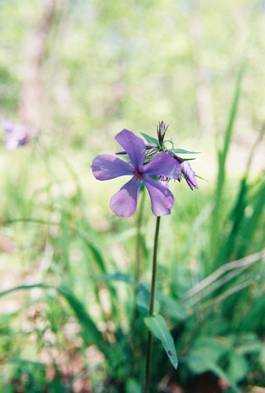 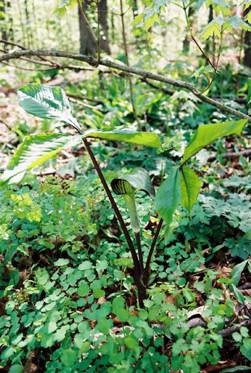 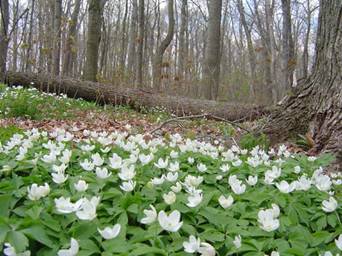 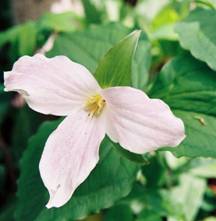
Native understory biodiversity (Heather Patti and Judy Grove) |
Joy's objectives were to understand the effect of garlic mustard on native diversity, investigate the canopy dynamics as a mechanism for dispersal, and organize an eradication program. The research involved mapping the forest boundary, wetlands, tributaries, and 68 study plots using GPS and GIS, quantifying canopy structure and composition, collecting understory species data in paired plots, and promoting the enthusiasm and assistance of as many as forty community volunteers.
|
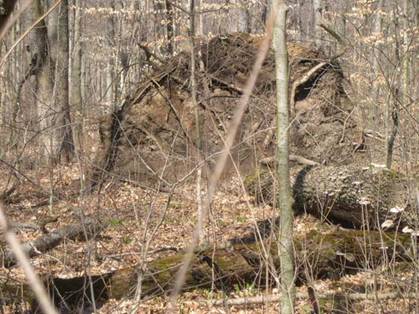 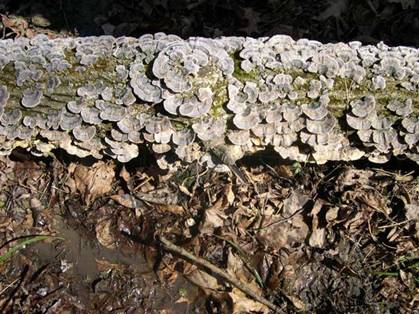
Treefall on top of an older treefall (left), and a fungus-covered fallen tree (right). Photos by Michael Stanton and Joy Wolf.
|
In this first year, she set up the plots in high quality areas of low to moderate invasion. Next year she plans to locate new plots in the more densely invaded areas. This research provides an opportunity where students can learn about old-growth canopy dynamics, the application of GIS to study canopy development and forest sustainability, and issues of biological invasion and fragmentation. The study strengthens community outreach and partnerships between UW-Parkside and other ecologically conscious organizations as well as land use managers. Stay tuned for more at the next AAG meeting in Chicago!
|
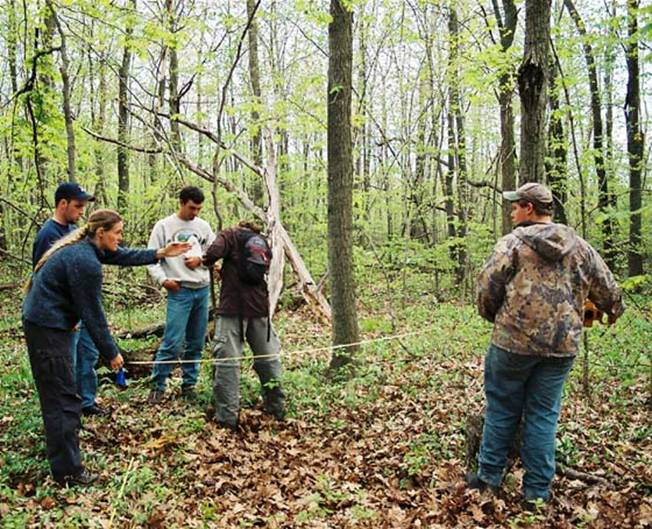
Creating transects and plots to collect canopy and understory data.
|
________________________________________________
Charles Lafon and Henri Grissino-Mayer
The Nature Conservancy’s Narrows Preserve protects the habitat of the Peters Mountain mallow (Iliamna corei Sherff.), a federally endangered plant species restricted to the western end of Peters Mountain, Giles County, Virginia. The population of the species has declined since its discovery in 1927 (Dunscomb and Edwards 2001), reaching a low of only three individuals by the early 1990s. Fire exclusion probably contributed to the decline of this fire-dependent species, which requires fire for seed scarification and successful germination. It also thrives in the sunny conditions that are maintained by periodic burning. The Nature Conservancy has initiated a prescribed burning program and has met some success in restoring the mallow’s population and habitat.
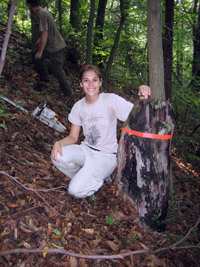 |
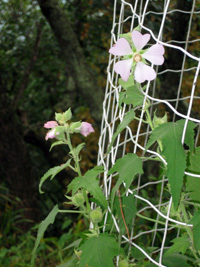 |
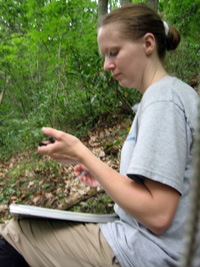 |
| Fig. 1. Jennifer Hoss with a fire-scarred pine snag. The catface, visible on the left side of the tree, contains approximately 10 fire scars. |
Fig. 2. The Peters Mountain mallow in bloom. The exclosure protects the plants from deer browsing, and also prevents the mallows from escaping. |
Fig. 3. Georgina Wight collecting GPS data for one of the fire-scar samples. |
The Nature Conservancy is funding Charles Lafon, Texas A&M University, and Henri Grissino-Mayer, University of Tennessee, along with graduate students Jennifer Hoss (Texas A&M) and Georgina Wight ( University of Tennessee), to conduct a dendroecological study to reconstruct the fire regime that maintained the habitat of the mallow during the past. They collected 80 fire-history samples from living and dead fire-scarred pines during summer 2005. They also established plots to characterize the species composition and age structure of the forest in the vicinity of the mallows. The forest is dominated by hardwoods (mostly oaks). Preliminary results suggest that fires occurred frequently prior to the era of fire exclusion, and that much tree establishment occurred after frequent burning had ceased. The lack of fire on this landscape may be leading to an increase in tree density and hence a decline in favorable habitat for the Peters Mountain mallow.
________________________________________________
Matt Beaty and Amy Griffin
Characterising linkages between urban pattern and ecological and social processes in Australia.

Only recently have scientists taken an interest in understanding how cities are organized and function as complex ecological systems. This perspective is a departure from earlier ecological studies of cities and urbanising landscapes that focused primarily on the detrimental impacts of urbanisation on biodiversity and ecosystem services. Through a partnership with CSIRO Sustainable Ecosystems, the University of New South Wales, and Sydney Olympic Park Authority, Matt Beaty, CSIRO Sustainable Ecosystems and Amy Griffin, University of New South Wales, both in Canberra, Australia are working on research that makes an important contribution to this new direction in urban ecosystem research. Their research is a novel integration of ecological and social data to identify relationships between urban patterns, human physical activity and health, and urban biodiversity. Through case studies in Sydney, they address four main research objectives:
- Develop a detailed spatial understanding of urban patterns (e.g., urban form, land use connectivity, intensity and heterogeneity) with an approach that integrates high resolution remote sensing, ecological, social, and economic data to identify alternate urban development patterns and pathways;
- Examine the influence of urban patterns on public health as measured though human physical activity, an indicator of risk for a range of diseases and other medical problems;
- Examine linkages among urban patterns and the ecological characteristics of urban remnant native vegetation, managed greenspace, and selected fauna; and
- Identify how an understanding of these relationships may inform the design and sustainable management of urban ecosystems.
The project duration is two years, and they have just completed the remote sensing work and begun collecting field data.
For more information, please contact Matt Beaty (Email: matt.beaty@csiro.au; Web: www.cse.csiro.au).
________________________________________________
Chad Lane
Biogeography Specialty Group Ph.D. Research Grant
Chad Lane’s proposed Ph.D. research focuses on the paleoenvironmental reconstruction of two small mid-elevation lakes in the Dominican Republic. He is particularly interested in the impacts of late Holocene climate change on natural ecosystems and human populations. Numerous paleoenvironmental records from the circum-Caribbean region have produced evidence of widespread late Holocene droughts that significantly impacted natural ecosystems and human populations. Chad plans on using multiple paleolimnological proxies of environmental change to assess the both the occurrence and impacts of such droughts on ecosystems and human populations in the Dominican Republic. He has used part of his Biogeography Specialty Group Ph.D. Research Grant award for an AMS radiocarbon date (410 14C yr
BP) used to bracket a period of human occupation around Laguna Salvador, which will allow him to estimate the time of prehistoric human abandonment and to calculate mineral and organic carbon
influx rates during the period of human occupation. He plans to use the remaining funds for another radiocarbon date for Laguna Salvador or for laboratory supplies necessary for compound-specific isotopic analyses. |
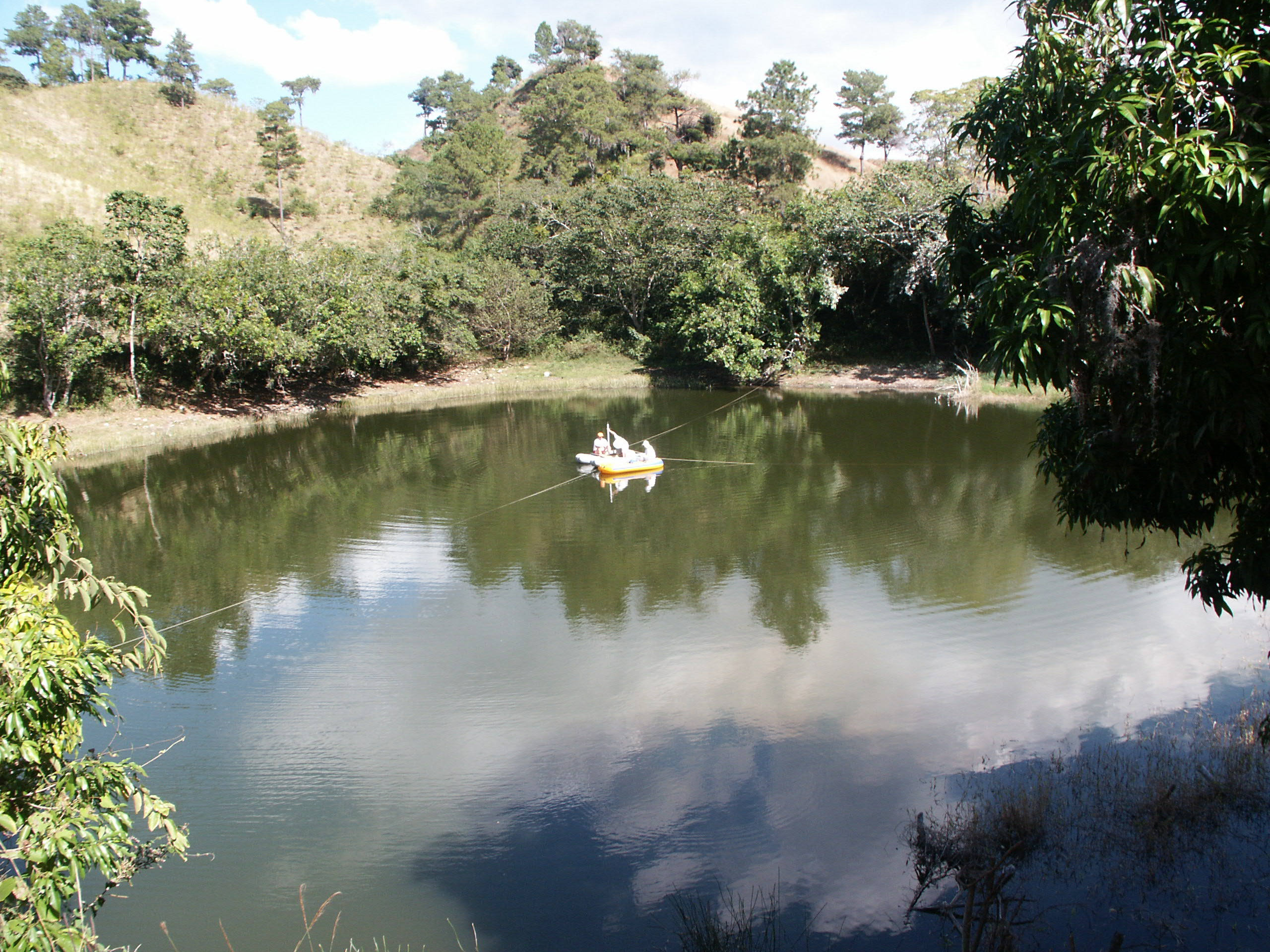
Collecting sediment cores
|
Back to the top.
Book Notes
Call for Contributors
GREENWOOD GUIDES TO BIOMES OF THE WORLD
An 8-volume set of books directed toward advanced middle school and younger high school students is scheduled to be published by Greenwood Press in 2007. This will be a reference work, not a series of textbooks. Greenwood Press markets to school libraries.
The set editor is seeking authors for several of these volumes. The volume titles are as follows:
1. Introduction to Biomes
2. Tropical Forest Biomes
3. Temperate Forest Biomes
4. Grassland Biomes |
5. Desert Biomes
6. Arctic and Alpine Biomes
7. Freshwater Biomes
8. Marine Biomes |
Each book will consist of 224 printed pages (approximately 75,000 words) and include discussions of two or three different biomes. A strong emphasis will be placed on illustrations (maps, line drawings, half-tones, and an 8-page color section). Since this is a set, conformity in format and the nature of the content to a prototype will be required. It is also essential that all manuscripts by completed at the same time. Compensation will be via royalties per volume. The Press does provide a small advance on royalties.
In addition to compiling information and writing the text, authors will be expected to find (or at the very least suggest) appropriate illustrations. Prior research in the biome is not a requirement. The ability to extract information from diverse sources and write clearly and concisely is much more important. The set editor and a schoolteacher who works at the targeted grade levels will assist you in writing for the intended audience. Authors MUST be able to produce a completed manuscript by January 30, 2007. This will be subject to final editing by the set editor and the Press for a project completion date of April 2007.
Anyone interested in participating in this project by authoring one or two volumes should send a letter of interest (email is fine) to the set editor. (Later, a more formal application by selected authors will be necessary for a contract with the Press.) Please indicate which volume(s) you are interested in writing and give an overview of your writing and teaching experience. Preference will be given to college professors and advanced graduate students with experience teaching undergraduates and/or writing for general audiences.
I’ll be happy to try to answer any questions you may have.
Susan L. Woodward, set editor
Department of Geography
Radford University
Radford, VA 24142-6938
swoodwar@radford.edu
Back to the top.
Internet Resources
Charles Smith, Professor and Science Librarian at Western Kentucky University, maintains an amazing series of web sites that are a treasure trove of information for anybody with an interest in the history of biogeography. In addition to The Alfred Russel Wallace Page he maintains two enhanced bibliographies with links to full-text of many of the items listed, and biographical information on the authors:
He has recently added a new website, Some Biogeographers, Evolutionists and Ecologists: Chrono-Biographical Sketches, which includes some 250 profiles of leading naturalists of the past. Charles encourages users to send feedback and corrections to charles.smith@wku.edu. For more information, including links to his many other web resources, go to http://www.wku.edu/~smithch/index.html .
EstimateS diversity estmation software
http://viceroy.eeb.uconn.edu/EstimateS
EstimateS (current version 7.5) is a free software application by Robert Colwell that computes a variety of biodiversity functions, estimators, and indices based on users' sample relative abundance or presence/absence data (available features and indices vary by data type). In addition to calculating a variety of diversity estimators, some of the functions include rarefaction, species accumulation curves, random resampling, a great random number generator, and a shuffle tool for exploring the effects of spatial patchiness on species richness estimators. EstimateS is available for both Windows and Macintosh platforms and includes a comprehensive User's Guide.
Geography 4900, Introduction to Biogeography
http://www.valdosta.edu/~grissino/geog4900/
Henri Grissino-Mayer created this web when he taught at Valdosta State College, and while Henri moved on, the web site is is still available. Those of us teaching introductory biogeography would do well to model our course web sites after this one. It includes links to a well-developed syllabus, lecture notes, and resources for students including "How to Take Notes," "How to Take Tests," and "How to Write a Research Paper."
The following links and descriptions (with some editing) are taken or adapted from The NSDL Scout Report, Copyright Internet Scout Project 1994-2005.
The Academy of Natural Sciences-Research: Center for Systematic Biology and Evolution
http://www.acnatsci.org/research/biodiv/index.html
The Center for Systematic Biology and Evolution at the Academy of Natural Sciences engages in biodiversity research that “involves the discovery of species and the working out of the relationships among those species, why they are distributed as they are in the world, and their interactions with other species.” This website provides information about the collections and research activities of the Center’s many departments including Botany, Diatoms, Herpetology, Ichthyology, Mammalogy, Ornithology, Vertebrate Paleontology, and more. A link to the Collections Database allows visitors to search a portion of the Academy’s extensive biological collections containing over 17 million specimens. The site also links to other sections of the Academy of Natural Sciences website including a Staff Directory; the Scientific Publications Department; available employment opportunities and internships, and information about research opportunities for undergraduate, graduate, and postdoctoral students.
The Association for Tropical Biology and Conservation
http://www.atbio.org/
The Association for Tropical Biology and Conservation (ATBC) was originally established in 1963 as the Association of Tropical Biology (ATB) with the central goal of promoting research and fostering “the exchange of ideas among biologists working in tropical environments.” In 2002, ATB members voted to revise the organization's name to include the Conservation component and to set forth an expanded mission for the ATBC “as an international body to promote research, education, conservation, and communication in tropical biology.” The ATBC website contains information about
_Biotropica_ (the quarterly research journal of the ATBC) including contents and abstracts from past issues; instructions for authors, and the names, and fields of expertise of editorial board members. In addition, the site contains downloadable copies of
_Tropinet_, a quarterly newsletter that offers tropical biologists a forum as well as a source for information about grants, employment opportunities, new publications, and meetings. ATBC also provides information about membership, past and upcoming Annual Meetings, and contacts for Officers and Staff.
Zoological Society of London: Institute of Zoology
http://www.zoo.cam.ac.uk/ioz/
As the research division of the Zoological Society of London, the Institute of Zoology (IoZ) “conducts basic biological research which benefits the conservation of animal species and their habitats.” The IoZ website provides summaries of the Institute’s seven Research Themes including Wild Animal Health and Welfare; Behavioral and Evolutionary Ecology; Biodiversity and Macroecology, and Reproductive Biology, to name a few. In addition, the site provides information about IoZ researchers, specific research projects, services, publications, postgraduate research opportunities, and job opportunities when available. Site visitors will also find downloadable IoZ Annual Reports from the past few years, and information about upcoming scientific meetings.
National Wetlands Research Center: Library Digital Collection
http://www.nwrc.usgs.gov/diglib.htm#biorpts
The National Wetlands Research Center (NWRC) "is a source and clearinghouse of science information about wetlands in the United States and the world for fellow agencies, private entities, academia, and the public at large." The NWRC Library Digital Collection contains an abundance of technical reports in pdf format spanning the last couple decades from such institutions as the US Fish and Wildlife Service; the USGS Biological Resources Division; and the National Biological Service. The site also contains an archived Species Profiles collection from the US Fish and Wildlife Service with 126 downloadable profiles "designed to provide coastal managers, engineers, and biologists with a brief, comprehensive sketch of the biological characteristics and environmental requirements of the species and to describe how populations of the species may be expected to react to environmental changes caused by coastal development." The Library Digital Collection archives contain a Habitat Suitability Index Models Series and a Waterfowl Management Handbook from the US Fish and Wildlife Service as well.
Duke University: The Clark Lab
http://www.biology.duke.edu/clarklab/index.html
Based at Duke University, the Clark Lab "conducts research in plant community ecology, paleoclimate and fire ecology." The lab website contains brief descriptions of various research projects on Forest Dynamics and Environmental Change, Dispersal and Tree Population Migration, Molecular Biogeography, and New Computational Approaches for Forest Dynamics, to name a few. Notably, the site contains a nice selection of downloadable articles that have appeared in such publications as
Ecology,
Forest Ecology and Management,
Ecological Monographs, Nature, and Canadian Journal of Forest Research. The site also offers brief information about several lab members including email addresses.
In this 21-page article, Oregon State University researchers William J. Ripple and Robert L. Beschta summarize "the status of wolves (Canis lupus), elk (Cervis elaphus), and woody browse conditions during the 20th century for the upper Gallatin elk winter range in southwestern Montana, USA." The article appeared in _Forest Ecology and Management_ in 2004, and this pdf version is electronically archived by Sinapu, an organization "dedicated to the restoration and protection of native carnivores and their wild habitat in the Southern Rockies, and connected high plains and deserts." The article includes sections regarding the Study Area, Methods, Results, and Conclusions. The Results section addresses Long-term Conditions and Trends for Wolves, Elk, Vegetation, and Climate. The article also includes a Discussion segment with subsections for three distinct periods: Pre-1925, Wolves Present; 1925-1995, Wolves Extirpated; and Post-1995, Wolves Reintroduced.
Back to the top
Recent Member Publications
Publications Editor: Henri Grissino-Mayer
Listed by person submitting references.
David Butler, Texas State University, San Marcos, Texas
Allen, T.R., S.J. Walsh, D.M. Cairns, J.P. Messina, D.R. Butler, and G.P. Malanson. 2004. Geostatistics and spatial analysis: characterizing form and pattern at the alpine treeline. In: GIScience and Mountain Geomorphology (M.P. Bishop and J.F. Shroder, Jr., eds.), Springer Verlag - Praxis Scientific Publishing, Heidelberg, Germany, 189–214.
Butler, D.R. 2004. Zoogeomorphology. In: Encyclopedia of Geomorphology, Volume 2 (A. Goudie, ed.), Routledge, London, 1122–1123.
Butler, D.R., G.P. Malanson, and L.M. Resler. 2004. Turf-banked terrace treads and risers, turf exfoliation, and possible relationships with advancing treeline. Catena 58(3): 259–274.
Cerney, D.L., and D.R. Butler, 2004. Examining montane ecotone change with repeat photography. Papers of the Applied Geography Conference 27, St. Louis, MO, 111-121.
Malanson, G.P., D.R. Butler, and S.J. Walsh. 2004. Ecological response to global climatic change. In: WorldMinds: Geographical Perspectives on 100 Problems (D.G. Janelle, B. Warf, and K. Hansen, eds.). Kluwer Academic Publishers, Dordrecht and Boston, 469–473.
Resler, L.M., M.A. Fonstad, and D.R. Butler. 2004. Mapping the alpine treeline ecotone with digital aerial photography and textural analysis. Geocarto International 19(1): 37–44.
Walsh, S.J., D.J. Weiss, D.R. Butler, and G.P. Malanson. 2004. An assessment of snow avalanche paths and forest dynamics using Ikonos satellite data. Geocarto International 19(2): 85–93.
Ryan Danby, University of Alberta, Calgary
Danby, R.K. and D.S. Slocombe. 2005. Regional ecology, ecosystem geography and transboundary protected areas in the St. Elias Mountains. Ecological Applications 15(2): 405–422.
James Dyer, Ohio University, Athens, Ohio
Dyer, J.M. 2004. A water budget approach to predicting tree species growth and abundance, utilizing paleoclimatology sources. Climate Research 28: 1–10.
Dyer, J.M. 2002. A comparison of moisture scalars and water budget methods to assess vegetation-site relationships. Physical Geography 23: 245–258.
Doug Fischer, University of California, Santa Barbara
Fischer, D.T., and R.L. Church. 2005. The SITES reserve selection system: a critical review. Environmental Modeling and Assessment. In Press.
Pyke, C.R., and D.T. Fischer. 2005. Selection of bioclimatically representative biological reserve systems under climate change. Biological Conservation 121(3): 429–441.
Konrad Gajewski, University of Ottawa, Ottawa, Ontario, Canada
Bigelow, N., L. Brubaker, M. Edwards, S. Harrison, I. Prentice, P. Anderson, A. Andreev, P. Bartlein, T. Christensen, W. Cramer, J. Kaplan, A. Lozhkin, N. Matveyeva, D. Murray, A. McGuire, V. Razzhiven, J. Ritchie, B. Smith, D. Walker, K. Gajewski, V. Wolf, B. Holmqvist, Y. Igarashi, K. Kremenetskii, A. Paus, M. Pisaric and V. Volkova. 2003. Climate change and arctic ecosystems 1. Vegetation changes north of 55 oN between the last glacial maximum, mid-Holocene and present. Journal of Geophysical Research. 108 (D19): 8170.
Bouchard, G., K. Gajewski, and P. Hamilton. 2004. Biogeography of diatoms from the Canadian Arctic Archipelago. Journal of Biogeography 31:1955–1973.
Bunbury, J. and K. Gajewski. 2005. Modern ostracode assemblages from the southwest Yukon. Hydrobiologia 545: 117–128.
Gajewski, K., G. Bouchard, S. Wilson, J. Kurek, and L. Cwynar. 2005. Distribution of Chironomidae (Insecta: Diptera) head capsules in recent sediments of Canadian Arctic lakes . Hydrobiologia 549: 131–143.
Gajewski, K. and D. Atkinson. 2003. Climate change in the Canadian Arctic. Environmental Reviews 11: 69–102.
Leblanc, M., K. Gajewski, and P. Hamilton. 2004. A diatom-based Holocene paleoenvironmental record from a lake on the Boothia Peninsula, Nunavut, Canada. The Holocene 14: 423–431.
Leitner, R. and K. Gajewski. 2004. Modern and Holocene stomate records of treeline variations in northwestern Québec . Canadian Journal of Botany 82 : 726–734 .
Kauffman, D., T.A. Ager, N.J. Anderson, P.M. Anderson, J.T. Andrews, P.J. Bartlein, L.B. Brubaker, L.L. Coats, L.C. Cwynar, M.L. Duvall, A.S. Dyke, M.E. Edwards, W.R. Eisner, K. Gajewski , A. Geirsdóttir, F.S. Hu, A.E. Jennings, M.R. Kaplan, M.W. Kerwin, A.V. Lozhkin, G.M. MacDonald, G.H. Miller, C.J. Mock, W.W. Oswald, B.L. Otto-Bliesner, D.F. Porinchu, K. Rühland , J.P. Smol, E.J. Steig, and B.B. Wolfe (PARCS working group). 2004. Holocene thermal maximum in the western Arctic (0 o to 180 oW) Quaternary Science Reviews 23: 529–560.
Whitmore, J., K. Gajewski, M. Sawada, J.W. Williams, T. Minckley, B. Shuman, P.J. Bartlein, T. Webb III, A.E. Viau, S. Shafer, P. Anderson, and L. Brubaker. 2005. A North American Modern Pollen Database for Multi-scale Paleoecological and Paleoclimatic Applications. Quaternary Science Reviews 24: 1828–1848.
Wilson, S. and K. Gajewski. 2004. Modern chironomid assemblages and their relationship to physical and chemical variables from southwest Yukon and northern British Columbia Lakes. Arctic, Antarctic and Alpine Research 36: 432–441.
Zalatan, R. and K. Gajewski. 2005. Tree-ring analysis of five Picea glauca-dominated sites from the interior boreal forest in the Shakwak Trench, Yukon Territory, Canada. Polar Geography 29: 1–16.
Sawada, M., A. Viau, and K. Gajewski. 2003. The biogeography of aquatic macrophytes in North America since the last glacial maximum. Journal of Biogeography 30: 999–1017.
Sawada, M., A. Viau, G. Vettoretti, W.R. Peltier, and K. Gajewski. 2004. Paleoclimate model-data comparison for 6ka. Quaternary Science Reviews 23: 225–244.
Michelle Goman, Cornell University
Goman M. 2005. The development and application of a statistical calibration model of marsh sediment characteristics to the stratigraphic record. Journal of Sedimentary Research 75(3): 398–408.
Goman, M., A. Joyce, and R. Mueller. 2005. Stratigraphic evidence for anthropogenically induced coastal environmental change from Oaxaca, Mexico. Quaternary Research 63(3): 250–260.
Goman, M., and D. Leigh. 2004. Wet early to middle Holocene conditions on the upper Coastal Plain of North Carolina. Quaternary Research 61(3): 256–264.
Ashley, G.M., J. Maitma Mworia, A.M. Muasya, R.B. Owen, S.G. Driese, V.C. Hover, R.W. Renaut, M. Goman, S. Mathai, and S.H. Blatt. 2004. Sedimentation and recent history of a freshwater wetland in a semi-arid environment: Loboi Marsh, Kenya, East Africa, Sedimentology 51: 1–21.
Muasya, A.M , V.C. Hover, G.M. Ashley, R.B. Owen, M.F. Goman, and M. Kimeli. 2004. Diversity and distribution of macophytes in a freshwater wetland, Loboi Swamp (Rift Valley) Kenya. Journal of East African Natural History 93: 39–47.
Henri D. Grissino-Mayer, University of Tennessee, Knoxville
Dobbertin, M.K., and H.D. Grissino-Mayer. 2004. Bibliografie und Glossar zur Dendrochronologie: zwei neue Informationsquellen für die Jahrringforschung. Schweizerische Zeitschrift für Forstwesen 155(6): 238 –240.
Poore, R.Z., M.L. Pavich, and H.D. Grissino-Mayer. 2005. Record of the North American Southwest monsoon from Gulf of Mexico sediment cores. Geology 33(3): 209–212.
Wight, G.D., and H.D. Grissino-Mayer, 2004. Dendrochronological dating of an Antebellum Period house, Forsyth County, Georgia, U.S.A. Tree-Ring Research 60(2): 91–99.
Amy Hessl, West Virginia University
McKenzie, D., A.E. Hessl, L.B. Kellogg, and A.M. Morgan-Martinez. In press. Using neutral models to identify constraints on low-severity fire regimes. Landscape Ecology.
Hessl, A.E., C. Milesi, M. White, R. Keane, and D. Peterson. 2004 . Ecophysiological parameterization database for Pacific Northwest trees. USDA Forest Service General Technical Report PNW-GTR-618.
McKenzie, D., and A.E. Hessl. 2004. A neutral model of low-severity fire regimes. In: Proceedings of the 2002 Fire Conference, USDA Forest Service General Technical Report PSW-GTR-189.
Sally Horn, University of Tennessee
Arford, M.R. and S. P. Horn. 2004. Pollen evidence of the earliest maize agriculture in Costa Rica. Journal of Latin American Geography 3(1): 108–115.
Lane, C.S., S.P. Horn, and C.I. Mora. 2004. Stable carbon isotope ratios in lake and swamp sediments as a proxy for prehistoric forest clearance and crop cultivation in the neotropics. Journal of Paleolimnology 32: 375–381.
M. Kappelle and S.P. Horn, eds. 2005. Páramos de Costa Rica. Santo Domingo, Costa Rica: Editorial INBio. http://www.inbio.ac.cr/ES/compras/carrito/detalle_producto.phtml?146
Driese, S.G., Z-H Li, and S.P. Horn. 2005. Late Pleistocene and Holocene climate and geomorphic histories interpreted from 23,000 14C yr B.P. paleosol and floodplain soils, southeastern West Virginia, USA. Quaternary Research 63: 136–149.
Haberyan, K.A., and S.P. Horn. 2005. Diatom paleoecology of Laguna Zoncho, Costa Rica. Journal of Paleolimnology 33: 361–369.
Anchukaitis, K., and S.P. Horn. 2005. A 2000-year reconstruction of forest disturbance from southern Pacific Costa Rica. Palaeogeography, Palaeoclimatology, Palaeoecology 221: 35–54.
Orvis, K.H., C.S. Lane, and S.P. Horn. In press. Laboratory production of vouchered reference charcoal from small woody samples and non-woody plant tissues. Palynology.
Kennedy, L.M., S.P. Horn, and K.H. Orvis. In press. A 4000-yr record of fire and forest history from Valle de Bao, Cordillera Central, Dominican Republic. Palaeogeography, Palaeoecology, Palaeoclimatology.
Kennedy, L.M., S.P. Horn, and K.H. Orvis. In press. Modern pollen spectra from the highlands of the Cordillera Central, Dominican Republic. Review of Palaeobotany and Palynology.
Horn, S.P. Pre-Columbian maize agriculture in Costa Rica: Pollen and other evidence from lake and swamp sediments. In Histories of maize: Multidisciplinary approaches to the prehistory, biogeography, domestication, and evolution of maize, ed. J. Staller, R. Tykot, and B. Benz. San Diego, California: Elsevier Press.
Dominik Kulakowski, University of Colorado, Boulder
Bigler, C., D. Kulakowski, and T.T. Veblen. In press. Effects of disturbance interactions and extreme drought on fire severity in subalpine Rocky Mountain forests. Ecology.
Kulakowski, D., T.T. Veblen, and S. Drinkwater. 2004. The persistence of quaking aspen (Populus tremuloides) in the Grand Mesa area, Colorado. Ecological Applications 14(5):1603–1614.
John Kupfer, University of South Carolina
Kipfmueller, K.F. and J.A. Kupfer. 2005. Complexity of successional pathways in subalpine forests of the Selway-Bitterroot Wilderness Area, USA. Annals of the Association of American Geographers 95: 495-510.
Kupfer, J.A. and J.D. Miller. 2005. Wildfire effects and post-fire responses of an invasive mesquite population: the interactive importance of grazing and non-native herbaceous species invasion. Journal of Biogeography 32: 453-466.
Kupfer, J.A., J. Balmat and J.L. Smith. 2005. Shifts in the potential distribution of sky island plant communities in response to climate change. In: Biodiversity and Management of the Madrean Archipelago II: Connecting Mountain Islands and Desert Seas. Logan, UT: Rocky Mountain Research Station, U.S.D.A. Forest Service.
Kupfer, J.A. and C.W. Emerson. 2005. Remote sensing. In: Encyclopedia of Social Measurement, Vol. 3., ed. K. Kempf-Leonard. San Diego: Academic Press.
Charles W. Lafon, Texas A&M University
Lafon, C.W. 2004. Ice-storm disturbance and long-term forest dynamics in the Adirondack Mountains of New York, USA. Journal of Vegetation Science 15: 267–276.
Lafon, C.W. 2004. Stand dynamics of a yellow-poplar (Liriodendron tulipifera L.) forest in the Appalachian Mountains, Virginia, USA. Dendrochronologia 22: 43–52.
Lafon, C.W. 2005. Reconstructing fire history: an exercise in dendrochronology. Journal of Geography 104: 127–137.
Glen MacDonald, University of California, Los Angeles
Gajewski, K. and G.M. MacDonald. 2005. Palynology of Arctic Lakes. In: Long-term Environmental Change in Arctic and Antarctic Lakes, (ed) R. Pienitz , M.S.V. Douglas, and J.P. Smol. DPER Volume 8 book. Kluwer.
MacDonald, G.M., T.W.D. Edwards, B. Gervais, T.E. Laing, M.F.J. Pisaric, D.E. Porinchu, J.A. Snyder, N. Solovieva, P. Tarasov, and B.B. Wolfe. 2005 Palaeolimnological research from northern Russian Eurasia. In: Long-term Environmental Change in Arctic and Antarctic Lakes, (ed) R. Pienitz, M.S.V. Douglas, and J.P. Smol. DPER Volume 8. Kluwer.
MacDonald, G.M. and R.A. Case, 2005. Variations in the Pacific Oscillation over the Past Millennium. Geophysical Research Letters, 32, L08703,doi:10.1029/2005GL022478.
L.C. Smith, Y. Sheng, G.M. MacDonald, and L.D. Hinzman. 2005. Disappearing Arctic lakes. Science 3 June 2005; 308: 1429 [DOI: 10.1126/science.1108142]
Solovieva, N., P.E. Tarasov, and G. MacDonald. 2005. Quantitative reconstruction of Holocene climate from the Chuna Lake pollen record, Kola Peninsula, northwest Russia. The Holocene 15(1): 141–148.
Huang, C., G.M. MacDonald, and L.C. Cwynar. 2004. Holocene landscape development and climatic change in the Low Arctic, Northwest Territories, Canada. Palaeogeography, Palaeoclimatology, Palaeoecology 205: 221–234.
Kaufman, D.S., T.A. Ager, N.J. Anderson, P.M. Anderson, J.T. Andrews, P.J. Bartelein, L.B. Burbaker, L.L. Coats, L.C. Cwynar, M.L. Duval, A.S. Dyke, M.E. Edwards, W.R. Eiser, K. Gajewski, A. Geisodottir, F.S. Hu, A.E. Jennings, M.R. Kaplan, M.W. Kewin, A.V. Lozhkin, G.M. MacDonald, G.H. Miller, C.J. Mock, W.W. Oswald, B.L. Otto-Blisner, D.F. Porinchu, K. Rühland, J.P. Smol, E.J. Steig, amd B.B. Wolfe. 2004, Holocene thermal maximum in the western Arctic (0–180° W). Quaternary Science Reviews 23: 529–560 .
Kremenetski, K.V., T. Boettger, G.M. MacDonald, T. Vaschalova, L. Sulerzhitsky, and A. Hiller. 2004. Medieval climate warming and aridity as indicated by multiproxy evidence from the Kola Peninsula, Russia. Palaeogeography, Palaeoclimatology, Palaeoecology 209: 113–125.
Kremenetski, K.V., G.M. MacDonald, B.R. Gervais, O.K. Borisova, and J.A. Snyder. 2004. Holocene vegetation history and climate change on the northern Kola Peninsula, Russia: a case study from a small tundra lake. Quaternary International 122: 57–68.
Sheng, Y., L.C. Smith, G.M. MacDonald, K.V. Kremenetski, K.E. Frey, A.A. Velichko, M. Lee, D.W. Beilman, and P. Dubinin, P. 2004. A high-resolution GIS-based inventory of the west Siberian peat carbon pool. Global Biogeochemical Cycles 18 (GB3004, doi:10.1029/2003GB002190): 1–14.
Smith, L.C., G.M. MacDonald, A.A. Velichko, D.W. Beilman, O.K. Borisova, K.A. Frey, K.V. Kremenetski, and Y. Sheng. 2004. Siberian peatlands a net carbon sink and global methane source since the early Holocene. Science 303: 353–356.
Joy Mast, Carthage College, Kenosha, Wisconsin
Savage, M. and J.N. Mast. 2005. How resilient are Southwestern ponderosa pine forests after crown fires? Canadian Journal of Forest Research 35(4): 967–977.
Chambers, C. and J.N. Mast. 2005. Ponderosa pine snag dynamics and cavity excavation following wildfire in northern Arizona. Forest Ecology and Management 216: 227–240.
Kent, B. and J.N. Mast. 2005. Landscape change analysis of San Dieguito Lagoon, California: 1928–1994. Wetlands 25(3).
Kim Medley, Miami University, Oxford, Ohio
Medley, K.E., and H.K. Wafula. 2005. An ecological framework for participatory ethnobotanical research at Mt. Kasigau, Kenya. Field Studies 17(2): 302–314.
Medley, K.E. 2004. Measuring performance under a landscape approach to biodiversity conservation: the case of USAID/Madagascar. Progress in Development Studies 4(4): 319–341.
Wang, D.H., and K.E. Medley. 2004. Land use model for carbon conservation across midwestern USA landscape. Landscape and Urban Planning 69: 451–465.
Medley, K.E., C.M. Pobocik, and B.W. Okey. 2003. Historical changes in forest cover and land ownership in a midwestern U.S. landscape. Annals of the Association of American Geographers 93(1): 104–120.
Jim Speer, Indiana State University
Beilfuss, M.L. and J.H. Speer. 2005. Achieving scientific literacy in the undergraduate earth science classroom. Journal for the Liberal Arts and Sciences 9(4): 13–19.
Fritts, H.C. and J.H. Speer. 2005. Tree-Ring Analysis. Encyclopedia of World Climates, second edition. Kluwer Academic Publishers: 732–742.
Speer, J.H. 2005. Chapter 17: Extramural III: Doctoral Dissertation Research Improvement Grant. In: Gatrell, J.D., Bierly, G.D., and Jensen, R.R. (Eds.) Research Design and Proposal Writing in Spatial Science. Springer, Berlin. 216 pp.
Joy Wolf, University of Wisconsin - Parkside
Wolf, J.J., In press. Canopy spatial distribution in managed to unmanaged oak openings. Proceedings of the North American Prairie Conference, Madison, WI.
Wolf, J.J. 2004. A 200 year oak savanna fire history in southeastern Wisconsin. American Midland Naturalist 152: 201–213.
Mast, J.N. and J. Wolf. 2004. Ecotonal changes and altered tree spatial patterns in lower mixed-conifer forests, Grand Canyon National Park, Arizona, U.S.A. Landscape Ecology 19(2): 167–180.
Back to the top
Special Feature: BSG Statement on Evolution
It is stunning and unfortunate that evolution remains highly controversial in the United States. Nearly 150 years after Darwin and Wallace announced their theories of evolution, and eighty years after the Scopes "Monkey Trial," polls consistently show that about half of Americans reject evolution, though they also reflect a great deal of confusion about evolution, particularly human evolution. Well-funded efforts to undermine evolution in education have exploited this confusion to advance the cause of creationisms latest incarnation, "intelligent design."
As I write this, the Kitzmiller v. Dover Area School District trial is underway in District Federal Court about 60 miles south of here in Harrisburg, PA. It seems certain that the District will lose its case, and its biology teachers will not have to read a disclaimer in support of intelligent design before teaching evolution. If so, the larger forces supporting the defense (notably the Thomas More Law Center and the Discovery Institute) may appeal, or they may seek a stronger case. But they are clearly looking to take a case to the U.S. Supreme Court in the hopes that, by stripping creationism of its religious trappings, they will be able to slip it into biology curricula without running afoul of the First Ammendment. If that happens, local school districts and state legislatures will be able to bypass the scientific community entirely and set science education policy, including state school standards and curricula, according the ideological whim.
Creationists owe their public success in no small part to the scientific community's complacency. With a thousand more important things on our plates, we have not paid much attention to the intelligent design movement. The National Center for Science Education has sought to counter this complacency by rallying opposition to the ID movement through their Voices for Evolution project, which collects supporting statements from religious, civil liberties, education, and scientific and scholarly organizations.
At the 2004 business meeting, we began discussing the possibility of the BSG issuing a statement in support of teaching evolution and posting it with NCSE. Last year, the AAG gave us the go-ahead for this endeavor. Over the summer, the BSG Executive Board members circulated a draft statement, which will be forwarded to NCSE. The statement reads as follows:
The Biogeography Specialty Group of the Association of American Geographers affirms the fundamental importance and validity of evolutionary theory for understanding the origin, distribution, history, and diversity of life on Earth and thus its importance to the field of geography.
Evolution is a foundational principle of modern biology and the geosciences. It is supported by overwhelming evidence, and is accepted by the vast majority of scientists. We support extensive inclusion of evolution in state science standards and science curricula at all educational levels. We oppose all efforts to compromise, downplay, or diminish its centrality in science, including efforts to incorporate “intelligent design” (ID) into science curricula. We strongly endorse the resolutions of the American Association for the Advancement of Science regarding the place of contemporary evolutionary theory in science and science education.
We conceive science to be a systematic endeavor to describe, explain, and predict the material world in terms of natural forces and processes subject to empirical testing and verification. While it makes no overt references to a particular deity, ID is a metaphysical proposition. As such, it is unrelated to scientific inquiry and should have no connection to science instruction. Intelligent Design produces no testable hypotheses, its assertions can never be rigorously tested. Moreover, by invoking a supernatural to explain phenomena we do not yet understand, ID forfeits the possibility of deriving naturalistic explanations, and
We recognize that metaphysical viewpoints play important roles in all cultures and societies, respect the rights of all individuals to believe and worship as they see fit, and affirm the worthiness of religion as a subject of geographic inquiry. We support the study of the rich diversity of religious belief in comparative and neutral contexts, but metaphysical concerns have no place in science classrooms.
Americans’ lagging understanding of science and math threaten our global economic and technological competitiveness. Science instruction must not be distracted by unrelated subjects. Intelligent design and other pseudoscientific concepts do not contribute to developing the basic understanding that will allow students to navigate the world they will inherit: quite the opposite, they are distractions we can ill-afford. Biogeography Specialty Group of the Association of American Geographers opposes their inclusion in school science curricula.
Adopted 11/1/05
American Association for the Advancement of Science Board Resolution on Intelligent Design Theory (2002) |
Back to the top
Editor's Note
Two important changes mark this edition of The Biogeographer. First, Henri Grissino-Mayer has taken on the task of Recent Publications editor, which means that we will now have recent pulications in each issue of the newsletter, rather than only in the spring. Your editor is deeply grateful to Henri for taking on the task of organizing and formatting the publications list.
Second, the Internet Scout Report has stopped producing its Life- and Physical Science Reports, which were the primary source of our Internet Resources feature. I will continue to populate the feature with my own bookmark lists, and for the sake of diversity, I'll ask you to do the same. Share your favorite internet resources with us by sending the name of the site, a URL, and preferably a brief description (these can be combined if you like).
As usual, the spring edition of the newsletter will include recent member publications (please format your entries in the Chicago B style used in the Annals), so please consider contributing something to the Research-, Course-, Book-, or Field Notes sections. Note that your editor, who works cheap, usually just cuts and pastes whatever he gets, so please spell-check and proofread your sumbissions, and send them as email attachments in either html, MS Word, or Rich Text Format. I encourage you to send photos, but please crop them to the sizes you see in this and earlier editions of the newsletter (700 x 500 pixels is a good guide for maxium size).
Thanks to everybody who sent material, and to the BSG board members for proofing the draft newsletter.
Duane A. Griffin
Editor, The Biogeographer
Dept. of Geography
Bucknell University
Lewisburg, PA 17837 USA
Ph. 570/577-3374
dgriffin @ bucknell.edu
Back to the top.
 Here is how the grant review process works. The NSF panel meets twice a year and reviews around 160+ proposals at each meeting. Each grant proposal is first sent out for six or more external reviews, and also sent out to be reviewed by the fourteen GRS panel members. All of the written reviews are then submitted into the Fastlane Review system. The panel meets in Washington D.C. for two intense days of reviewing and categorizing the proposals into funding recommendations. During these panel meetings, one panel member is in charge of presenting each proposal to the full panel and summarizing the key points from the external reviews. A second panel member is in charge of also carefully reviewing the proposal and external reviews to provide a second opinion. Following discussion by the full panel, the proposal is “judged” on a five level gradient ranging from “not fundable” to “excellent—highest priority for funding”. My ponderings on this process will focused on what it actually takes for a grant to move from the fourth highest level, “very good” (= no funding, in many cases), to the highest level, “excellent” (= funded, in most cases).
Here is how the grant review process works. The NSF panel meets twice a year and reviews around 160+ proposals at each meeting. Each grant proposal is first sent out for six or more external reviews, and also sent out to be reviewed by the fourteen GRS panel members. All of the written reviews are then submitted into the Fastlane Review system. The panel meets in Washington D.C. for two intense days of reviewing and categorizing the proposals into funding recommendations. During these panel meetings, one panel member is in charge of presenting each proposal to the full panel and summarizing the key points from the external reviews. A second panel member is in charge of also carefully reviewing the proposal and external reviews to provide a second opinion. Following discussion by the full panel, the proposal is “judged” on a five level gradient ranging from “not fundable” to “excellent—highest priority for funding”. My ponderings on this process will focused on what it actually takes for a grant to move from the fourth highest level, “very good” (= no funding, in many cases), to the highest level, “excellent” (= funded, in most cases). 
